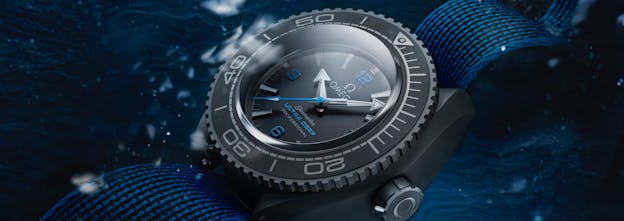The Diving Record Saga
Diving watches are like diving itself: records have been broken in stages. We trace the story of an exceptional adventure in the deep, where even light dare not venture.
People talk about watches being waterproof all the time, but those who can supply an accurate definition of what that actually means are few and far between. Waterproofness is not in fact measured in terms of how impermeable a watch is to a liquid, but by its capacity to resist the pressure exerted by a liquid. That’s why the performance of a waterproof watch is expressed as a measurement of pressure, in bars or atmospheres. These are more or less equivalent: 1 bar = 1 atmosphere = 1 kilogram-force/cm².
Relevant standards include NIHS 92-10 (ISO 2281) for water-resistant watches and the more specific NIHS 92-11 (ISO 6425) for the water resistance of diving watches; several characteristics over and above water resistance itself are covered, too: these include brightness, impact resistance (ISO 1413), magnetic field resistance (ISO 764), and the sturdiness of the strap.
In theory, any “diving watch” is supposed to meet these standards. In practice, watchmaking firms started testing their timepieces well before the advent of ISO standards, and well before the very idea of setting and breaking records existed.
It all began with the very first water-resistant watch, the 1926 Oyster from Rolex. Panerai followed, supplying the Italian divers of the 1940s with timepieces fitted with Rolex movements. Later, Panerai established the essential ingredients of the diving watch: a large case (made from steel; cushion-shaped; 47 millimetres in diameter for the first Radiomirs); luminous numerals and hour markers; a high-quality manual wind mechanical movement (back in the day, a Cortebert/Rolex 618 caliber from a pocket watch was used) and a water-resistant strap (for the first Panerais, this was in dyed leather and long enough to be worn on top of protective clothing).
The Pioneers
The diving watch went on to enjoy considerable success in the 1950s. In 1953, Blancpain presented its Fifty Fathoms, the first modern divers’ watch, produced at the request of the French army’s combat frogmen. Aquastar, now almost forgotten, developed the Benthos 500, a watch waterproof to depths of 300 metres. Doxa also lined up some great firsts: unveiled at Baselworld and first marketed in 1967, its Doxa Sub concept became the first fully professional diving watch to be affordable for a wider audience.

Enthusiasm for diving reached further heights (or depths) thanks to one of its heroes: Jacques-Yves Cousteau, who popularised both the discipline and its equipment. It was in his day that several brands brought out models waterproof to 300 metres or more: these included Seiko’s 6215 from its Professional 300 collection, Eberhard’s Scafograf 300, and the Vulcain Nautical (1970). This depth became a standard for the general public. That didn’t stop the quest for depth records, though, in which Rolex, Omega (with its Ploprof), and Seiko (with the Prospex) led the field.

The Role of Rolex
Rolex clocked up a large number of records. In 1960, in the Pacific Ocean, the bathyscaphe Trieste descended to a depth of 10,916 metres in the Mariana Trench, the deepest part of the world’s oceans. An experimental Rolex, the Deep Sea Special, was fitted to the outside of the hull – and remained undamaged by the colossal pressure of over one tonne per square centimetre. When the bathyscaphe returned to the surface, the watch was still displaying the correct time, proving that it had continued working throughout the dive. Omega followed in 2019, going deeper still: at the helm of his submarine Limiting Factor, explorer Victor Vescovo reached a depth of 10,925 metres, also in the abyss of the Mariana Trench. At his side, the Omega Seamaster Planet Ocean Ultra Deep Professional withstood the tremendous pressure at the sea bed – in style.

Rolex persisted too. In 1978, it presented a new Sea-Dweller, the 4000, waterproof to 1220 metres (4000 feet), succeeded in 2008 by the Oyster Perpetual Rolex Deepsea, waterproof to 3900 metres. This featured the distinctive architecture of the Ringlock case, in which an ultra-strong compression ring, located in the middle of the case, protects the 5.5-millimetre thick crystal and the titanium alloy caseback from the huge pressures exerted at great depths. More recently, in 2012, Rolex accompanied James Cameron on his Deepsea Challenge expedition. On 26 March, he descended alone on board a submarine to a depth of 10,908 metres – also in the Mariana Trench, the deepest part of the world’s oceans, in the Pacific.


The Future of Diving
Humankind has now reached the deepest places on earth – accompanied by watches. There are no more records left to be broken in that respect. Meanwhile, the watchmaking industry has set itself a standard that seems to suit most brands and collectors: 300 metres, as evidenced by blockbusters such as Omega’s Seamaster 300, Eberhard’s Scafograf 300, the Doxa Sub 300, and the like.

Future record-breaking attempts are therefore likely to be more technical in nature, seeking to make timepieces more efficient rather than endure greater depths. In this respect, emerging brand Mauron Musy is already one step ahead, successfully dispensing with gaskets altogether. Their ‘nO-Ring’ technology combines three principles: mechanical water resistance, an assembly flange, and a satellite compression spring. This combination of solutions is a real paradigm shift, taking waterproofness to the level of an ‘exterior complication.’



